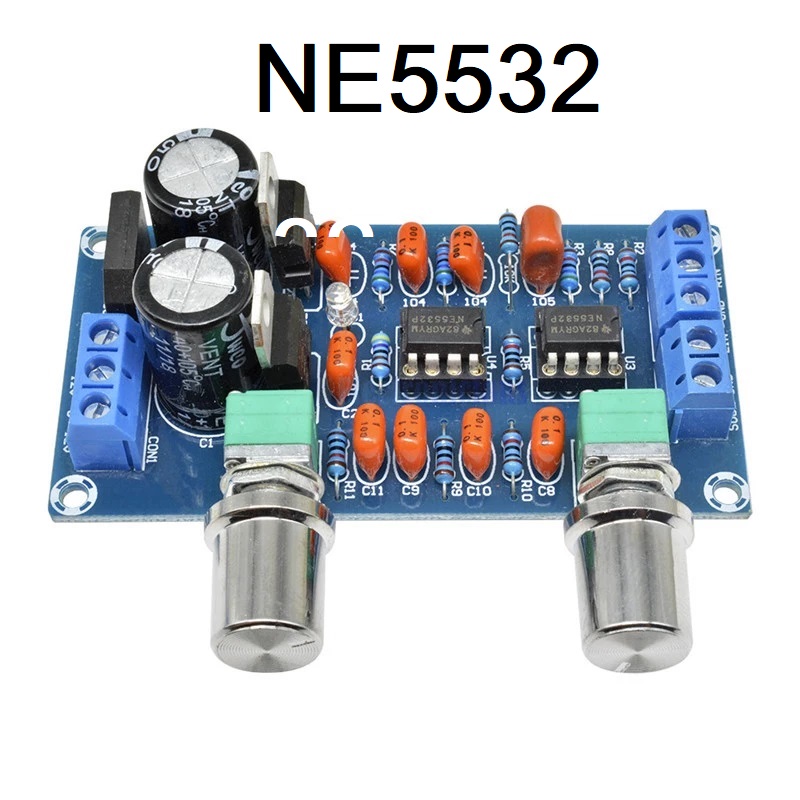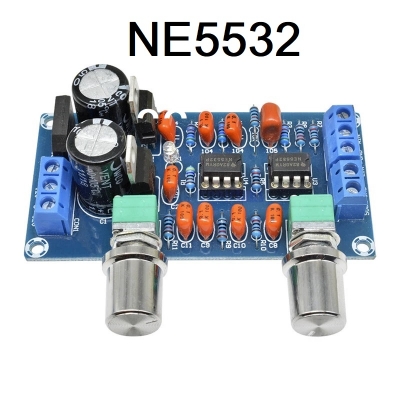Description: 2 VOLUME NE5532 Preamplifier Volume Control Board Low Pass Filter
A 2-Volume NE5532 Preamplifier Volume Control Board with Low Pass Filter is an audio preamplifier circuit designed to amplify weak audio signals before they are sent to a power amplifier. The NE5532 is a widely used, high-performance operational amplifier, known for its low noise and distortion. This specific board typically includes volume control for adjusting the signal output level and a low pass filter to limit high-frequency noise or unwanted signals.
Here's a breakdown of the key components and their roles:
1. NE5532 Operational Amplifier:
-
Role: The NE5532 is the heart of the preamplifier circuit. It amplifies the input audio signal to a higher level so it can be processed by a power amplifier.
-
Features:
-
Low noise and distortion
-
Dual op-amp (meaning it contains two independent amplifiers)
-
High input impedance, making it suitable for use in audio circuits where high fidelity is important.
-
Can drive a wide range of audio frequencies.
-
2. Volume Control:
-
Role: The volume control allows users to adjust the output signal level. It typically works by varying the gain applied to the audio signal. On the board, it may be a potentiometer (variable resistor) that adjusts the signal strength.
-
Use: This feature gives users the ability to control the loudness of the audio output.
3. Low Pass Filter:
-
Role: A low-pass filter is used to eliminate high-frequency noise and unwanted signals above a certain cutoff frequency, allowing only the desired low-frequency audio to pass through.
-
Use: This helps clean up the audio signal, preventing hiss, hum, or other high-frequency interference from reaching the power amplifier. It ensures that only the necessary parts of the audio spectrum are passed on to the next stage of amplification.
-
Components: It typically involves capacitors and resistors arranged in a way to allow lower frequencies (e.g., below 20 kHz) to pass while attenuating higher frequencies.
4. 2-Volume Control:
-
Role: A 2-volume control design indicates that the preamp may allow independent adjustment of two audio channels (left and right) or two different inputs.
-
Use: This could be useful in a stereo setup, where each channel (left and right) can be controlled separately for precise balance adjustments or for switching between two audio sources.
5. Other Components:
-
Resistors and Capacitors: These will be used in conjunction with the NE5532 op-amp to set the gain, control frequency response, and implement the low-pass filter.
-
Power Supply: The NE5532 will require a dual power supply (typically ±15V or ±12V) to operate correctly. Ensure the power supply matches the required voltage for the preamplifier to perform optimally.
Application:
-
Purpose: The board is typically used in audiophile applications or in home audio systems where clean, amplified audio signals are required. It might be used before a power amplifier or in a mixing board.
-
Benefits: It improves the clarity of the audio, reduces noise, and ensures proper volume control, particularly in systems where precision in sound reproduction is critical.
Typical Schematic:
-
Input: Audio input goes to the NE5532, where it is amplified.
-
Volume Control: Adjusts the gain of the audio signal.
-
Low Pass Filter: Filters out high-frequency noise or unwanted signals.
-
Output: The amplified and filtered signal is sent to the next stage of amplification or processing.
If you’re interested in building or using this preamp circuit, you’ll likely find it in applications like:
-
Audio signal processing systems
-
Home theater setups
-
Guitar amplifiers
-
Hi-Fi audio systems
-
High-Quality NE5532 Op-Amp for Low Noise and Distortion
-
Dual Volume Control for Independent Left and Right Channel Adjustments
-
Low Pass Filter for High-Frequency Noise Suppression
-
Adjustable Gain Control
-
Power Supply Compatibility (Dual ±12V or ±15V)
-
Compact and Space-Efficient Design
-
Enhanced Audio Fidelity and Clarity
-
Versatility for Various Audio Applications
-
User-Friendly with Smooth Volume Adjustments
Customer Questions and answers :
Login to ask a question

 Trending Store
Trending Store  Quick Commerce
Quick Commerce  Grocery
Grocery  Electronics & Appliances
Electronics & Appliances  Health & Beauty
Health & Beauty  Home & Living
Home & Living  Mother, Baby & Toys
Mother, Baby & Toys  Sports, Fitness & Outdoors
Sports, Fitness & Outdoors  Fashion
Fashion  Automotive & Motorcycles
Automotive & Motorcycles  Special Weekly Offer
Special Weekly Offer  Stationery, Books & Music
Stationery, Books & Music  Garden & Pet Care
Garden & Pet Care  Trending Store
Trending Store  Quick Commerce
Quick Commerce  Grocery
Grocery  Electronics & Appliances
Electronics & Appliances  Health & Beauty
Health & Beauty  Home & Living
Home & Living  Mother, Baby & Toys
Mother, Baby & Toys  Sports, Fitness & Outdoors
Sports, Fitness & Outdoors  Fashion
Fashion  Automotive & Motorcycles
Automotive & Motorcycles  Special Weekly Offer
Special Weekly Offer  Stationery, Books & Music
Stationery, Books & Music  Garden & Pet Care
Garden & Pet Care 


